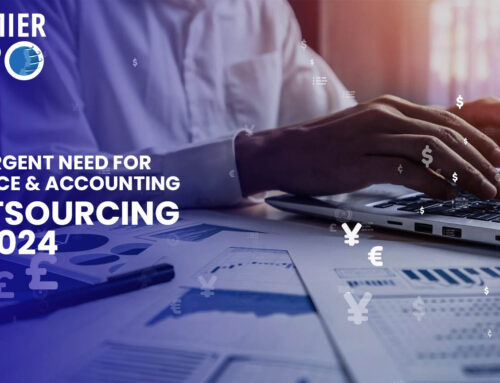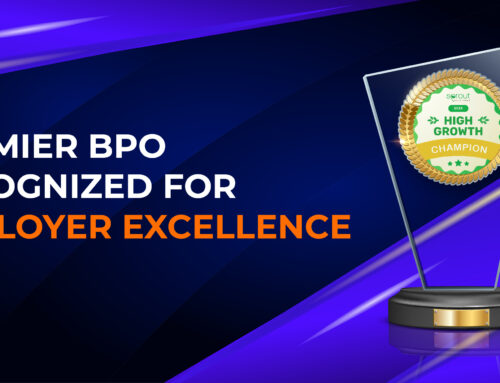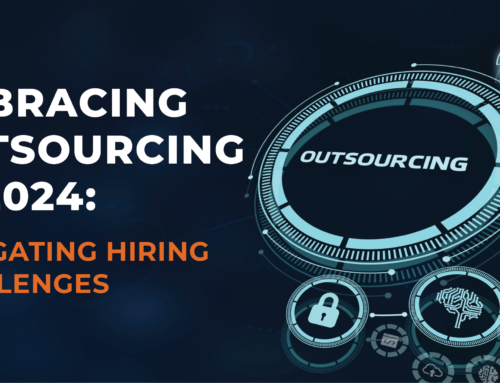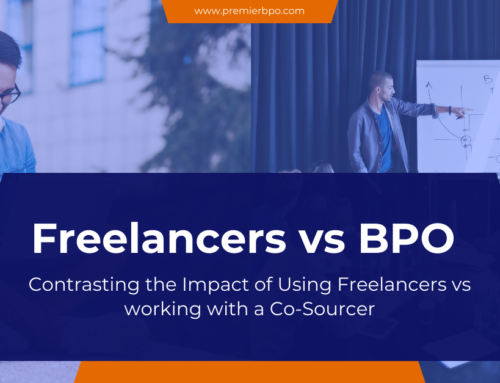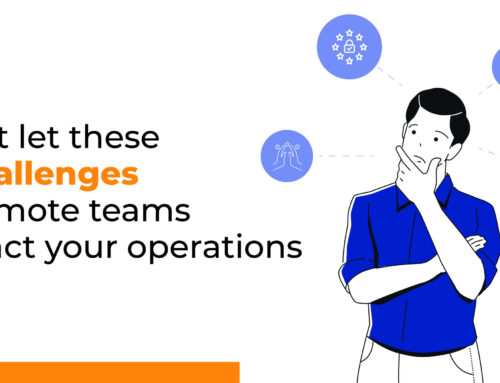Outsourcing has gradually become a permanent feature of businesses globally, especially when focused on cost-reduction, expansion of talent pool, and geographical redundancy. Whether you are an industry aficionado, long-term outsourcer, or someone who has just been introduced to the world of outsourcing, it is important to know the lingo that is frequently used in the industry to better comprehend and apply in everyday use. To help with that, Premier BPO has created our very own collection of Outsourcing terms to help anyone easily converse like an expert.

Below you will find a categorized vocabulary of Outsourcing Terms and general business terminology applied across multiple industries today:
Outsourcing Definitions
Outsourcing
The practice of contracting out or delegating to an external or third-party company for resources or services to perform your internal day-to-day company functions. E.g. IT Support, Customer Care, Contact Center, Accounting, etc.
Business Process Outsourcing (BPO)
A specific type of outsourcing in which one company utilizes the services such as Front-Office or Back-Office services from an external company, such as HR, Billing, Payroll, Call Center, etc.
Call Center
An office or virtual space dedicated to answering high volume calls for the customers of the organization; relating to queries, support, potential buyers etc. It may be Inbound or Outbound or both (Contact Center), while being a physical space, a virtual contact center, or a hybrid, utilizing both types.
Co-Sourcing
A type of outsourcing that makes the externally hired company part of your in-house team and promotes values of sharing risk and reward is Co-souring. It requires using specialized skills and resources for specific tasks.
Recruitment Process Outsourcing (RPO)
A form of Business Process Outsourcing where a company outsources its recruitment process to another organization which acts as an extension to your HR department. It not only provides expert consultation on new hires, but also saves time and money especially for ongoing interviews, shortlisting, and onboarding, etc.
Knowledge Process Outsourcing (KPO)
Outsourcing information-based business services that need a highly skilled/educated resource or subject-matter expert. For example, researching for legal advice, medical professionals, training, etc.
Build, Operate, Transfer (BOT)
An offshore contract-based development model in which one organization hires another to build and set up operations, which the external firm controls for a certain period of time, before transferring ownership to the parent company. Usually applied to financed large-scale projects or local government operations.
Information Technology Outsourcing (ITO)
A type of outsourcing that focuses on third-party services, support, and infrastructure related to IT processes, their applications, maintenance, software, technical solutions, and network implementation for the client’s business.
Crowdsourcing
The process of engaging a ‘crowd’ or group of people online for their expertise for innovative solutions, free resources, collective ideas, and public marketing for greater efficiency, connectivity, and problem-solving.
Insourcing
Transferring previously outsourced functions to an in-house department managed by internal employees is called insourcing. The opposite of outsourcing, it also refers to utilizing internal resources for specified functions, instead of using a third-party organization.
Legal Process Outsourcing (LPO)
Outsourcing legal, back-office processes or services to an external firm, typically for lower-cost resources, subject matter experts, and case management. It includes functions like consulting, transcription, documentation, compliance, litigation, etc.
Outsourcing by Location
Offshoring
Outsourcing outside the domestic country, typically in locations with a lower cost of living; for redundancy, expansion of operations, increased savings, and highly-skilled labor.
Right shoring
Placing a company’s operations in the optimum location that provides the highest combination of efficiency and lowered cost. Parts of the business are moved to locations that provide additional value.
Nearshoring
Contracting services or a country or region near to the location of the domestic company is nearshoring. It provides control over operations with a lowered cost of manufacturing. Example: U.S. companies outsourcing to Mexico.
Onshoring
Outsourcing business functions within national borders but to different states in the same country. It can be done to relocate operations in the domestic country, or for those organizations that do not have overseas operations at all. For example, two U.S. companies contracting services with each other.
Contact Center Terminology
Customer Care
A step further to Customer Service that includes high-quality, personalized assistance for empathic experiences, making sure that consumers are satisfied with the service. It includes pre-sale and post-sale support.
Customer Experience (CX)
The perception of your brand by a customer incorporating every interaction they have had with your company during their journey. Includes the customer’s feeling towards the product, service, their treatment, and whether or not they choose to repeat its use in the future.
Customer Relationship Management (CRM)
Strategies, software, and practices used to interact with customers, enhancing their experiences. It also enables the company to improve its relationship with its consumers; CRM tools are used for marketing and Customer Lifecycle Management.
Customer Satisfaction (C-SAT)
The measurement in scores of the satisfaction level of Customer Experiences after a transaction. It numerically defines the service level, helping to identify key performance indicators and areas to improve.
Net Promoter Score (NPS)
A metric used as a survey from customers in the form of a single question, with the answer received in numbers. The higher the number, the greater the overall positive response and customer satisfaction.
Omnichannel
Providing customers support across multiple channels simultaneously and on the platform of their choice without in break in service or lag in communication.
Multichannel
Support offered to clients from more than one channel or method of communication. For example, email, SMS, and chat.
Agent
A brand representative or person responsible for customer interactions employed by a particular organization. Sometimes also called a Customer Service Representative, they navigate the sale journey with the customer.
First Call Resolution (FCR)
the ability of a contact center agent to resolve customer problems at the first call; measured in percentages.
Automatic Call Distribution (ACD)
A telephony software used for automatically distributing incoming calls among agents in a Contact Center based upon predefined metrics. The calls may be distributed evenly, to the first available agent, or the concerned department; after being routed through IVR’s based on some simple questions. It helps streamline call center services by cross-referencing information and intelligently routing calls to the relevant agent, thereby reducing processing time.
Interactive Voice Response (IVR)
An automated phone system with pre-recorded or computerized voice that acts as the first point of contact for customers in a contact center for incoming calls. IVRs offer simple options or ask questions based on queries and then route calls to human agents according to customer responses. They help reduce average handle times, increase Customer Satisfaction, and aid in distributing calls to concerned agents while working in parallel with ACDs.
Lead Generation
A marketing strategy to attract prospects to your product or service by providing them more information and piquing the customer’s interest enough to qualify a sale.
Sales Development Representative (SDR)
An inside sales representative responsible for the outreach, prospecting, and qualifying of inbound leads.
Business Development Representative (BDR)
The first point of contact for a qualified prospect is a BDR. They are responsible for networking and prospecting through existing outbound leads to create potential buyers and retain or enhance existing partnership opportunities.
Average Handle Time (AHT)
A KPI metric used to analyze customer interactions with agents in contact centers, noting the duration of the transaction. It includes the time from the initiation of the call by the customer, to the talk-time, hold-time, transfers, and after-call work.
Abandoned Call
Where a customer hangs up or disconnects the call before connecting with a contact center representative; also referred to as a ‘lost call’. The call is transferred by the ACD to the agent but may get disconnected if the customer waits too long in the queue and terminates the session.
Home Agent
Dedicated agents that work from their home environment or another space, usually connecting to company servers online. Also known as remote agents, particularly for WFH contact center representatives.
Business Documentation Jargon
Statement of Work (SOW)
A document that gives the description of activities, work requirements, outlines, and expectations of a certain project.
Business Continuity Plan (BCP)
A document that highlights methods to effectively continue operations for an enterprise, in case of any emergency that may hinder or disrupt everyday processes, e.g., natural disasters, civil unrest, pandemic, etc. Created in advance as a contingency plan, it often intertwines and links with DRPs, which are more applicable for redundancy during system failure scenarios.
Disaster Recovery (DR)
Contingency used to regain access to systems or replicating operations in another location in case of disruption resulting from natural calamities and unforeseen circumstances such as fires, earthquakes, hardware failure, cyber-attacks, pandemics, etc. DR plans outline preventive measures as well as risk mitigation while resuming operations through data redundant technologies.
Payment Card Industry (PCI) compliance
A set of mandated security standards to be maintained by any company that utilizes or stores transactional information from a credit card. Its purpose is to protect the personal data of the card owner.
Full-Time Employee/Equivalent (FTE)
Refers to one person working full-time hours as a dedicated employee for a company, and paid according to standard working hours.
Limited Liability Company (LLC)
A US business structure that combines the best elements of partnerships, sole ownerships, and corporations to provide tax savings while offering limited liability and flexibility of laws to its members.
Service Level Agreement (SLA)
A contractual agreement between two companies that defines the terms of service between a provider and a client during the project timeline. It includes defined expectations, ways to measure performance, penalties, and procedures to follow which are mutually agreed upon by all parties involved.
Master Services Agreement (MSA)
A contract between two parties that outlines terms, expectations, and methods of future dealings for any number of transactions. It also defines schedules, the procedure for settling disputes, rights, and limitations, etc., and allows speedy negotiation for upcoming transactions.
Change Request
A request to add to, alter, or change a former agreement regarding a product or service. It can be initiated by either involved parties and is used to increase/decrease project scope, modify existing processes, add new ones, or extend deadlines.
Point of Contact (POC)
The person or department within a company assigned to handle day-to-day communication, customer interactions, inquiries, and requests as the company’s representative. POCs are highly familiar with the business and act as an extension of the company team they work for.
Key Performance Indicators (KPI)
Measurable points that identify the overall progress in an operation keeping in mind milestones achieved in a specific time. They can be applied to an individual, department, or the whole company.
General Terms
Business to Business (B2B)
Interactions or transactions between two business entities like manufacturer and wholesaler.
Business to Consumer (B2C)
Exchange of products or services directly between a business and its consumers
Back-Office Support
Solutions or services that are non-customer facing and administrative. The Back-office operates in the background but is critical to support the Front-office performance. Some Back-office functions include support for HR, Account Management, Payroll, etc.
Front-Office
The Customer-facing part of an organization or personnel/services that interact directly with the client base. These roles directly contribute to the image and revenue of the company. Some examples are Sales, Public Relations, Contact Center, etc.
Brick and Mortar
A physical location for a business to operate from, as followed by tradition; as opposed to online businesses where customers can visit in person to avail goods or services.
On-Premise
IT software installed on company systems in the physical site providing tactile access to data systems and their configuration as and when needed.
Business Process Management (BPM)
BPM is a best practice, method, and discipline of analyzing, monitoring, and improving existing work processes in an organization to improve outcomes. It is a repetitive process that often uses tools and automation for practical application.
Artificial Intelligence (AI)
utilizing machine or robotic intelligence to solve work-related problems and increase efficiency overall by making them mimic human interactions and take logical decisions.
Gamification
Introducing game elements in non-game or work environments to increase participation, promote idea stimulation, and add to the learning. It can be applied to engage employees internally, as well as consumers externally.
Content Moderation
The process of screening User Generated Content on a company’s web or social sites to ensure no offensive, irrelevant, unethical, or illegal content reaches your platform and audiences. May include text, posts, video, and images. Content moderators are also responsible for mitigating digital wildfires, keeping a consistent brand voice, and highlighting company services/products while maintaining set rules for each platform.
3PL
Also called Third Party Logistics; allows an organization to outsource logistics-related services to other companies that require services like Inventory management, warehousing, delivery, order fulfillment, freight forwarding, FTL, and LTL shipping, etc. It also includes supply chain and transportation services, similar to order fulfillment companies.
Small-to-Medium Enterprise (SME)
A division of enterprises based on size according to the number of employees, revenue, and assets. The term varies in size from country to country, but according to the U.S. standard, small enterprises constitute less than 250 seats, while Medium size enterprises can hold from 250 to 1000 seats.
Knowledge Base
A central database, repository, library, or collection of official documentation pertaining to any organization, its regulations, culture, published works, and internal and external processes. It is organized in a way that data regarding any topic is easily retrievable and helps employees navigate day-to-day practices regarding any situation, information required, client management, or official process.
Downsizing
Releasing or permanently reducing a company’s labor force based on organizational need or productivity is known as downsizing. Also referred to as layoff, most downsizing occurs to save on internal costs or to restructure an organization following a change like an acquisition or a merger.
Fixed Pricing (FP)
FP models in outsourcing are defined by standardized rates for a particular type of service by the service provider. Also called the lump-sum model, it works best for projects with clearly defined scope, deliverables, skills, capabilities, requirements, and milestones. They are suited to long-term projects and may be adjusted to the client’s needs, according to incentives or target metrics. All cost terms are decided between the two organizations before the project commences.
Global Delivery Model (GDM)
GDM Is the combination of methodologies, policies, procedures, HR functions, skills, and overall capability of an organization’s service provider/partner to globally deliver products and services; especially for IT-related businesses.
Labor Arbitrage
It refers to utilizing a low-cost workforce in different geographical locations (global labor arbitrage) where taxation laws are also lenient compared to domestic countries. As an effect of globalization, international trade barriers are removed, and highly skilled personnel is available for work in countries where living expenses are reduced.
Quality Assurance
Business Intelligence (BI)
A process that utilizes tools, software, and technology to collect and analyze a company’s historical and present data to make informed strategic decisions through actionable insights. BI encompasses techniques such as process analysis, analytical reporting, data mining, benchmarking, etc. The results are presented in easy-to-understand, visual formats such as graphs, charts, summaries, maps, and spreadsheets to optimize performance and profits.
Six Sigma
A management technique applied to enhance quality by reducing the internal likelihood of errors through the identification of issues based on mathematical and statistical data. It helps to improve a company’s performance, creating operational excellence by nearing processes to zero defects, highlighting the best course of action backed by data.
Software Testing
The process of evaluating software for errors to verify that it performs as intended by design (free of defects). It can be used to inspect systems, identify development gaps or bugs, and compare existing features with actual requirements. Testing procedures are applied to a product or service in the final stages before going live and seek to resolve and correct any issues that may arise.
Quality Assurance
Includes all systemic actions and procedures that ensure a product or service is created or delivered according to defined standards ensuring overall high quality. QA procedures are involved in the entire product lifecycle, are preventive in nature, and seek to improve where possible.
Compliance
The services or product provided by a company to another, in accordance with government or industry-defined rules, legislation, or specifications. E.g. to send warm transfer Medicare leads to licensed onshore US agents, contact center representatives must follow HIPAA compliance rules.
Application Program Interface (API) Testing
Also called Application Programming Interface Testing; it is used in Software Development testing to check the functionality, reliability, security, and performance of a program’s interface.
As most of these terms interlink with multiple industries, these also form part of the general business vernacular. Let us know if you’re looking for a particular definition, and we will add it to the list. Drop a query at our Contact Us page. Knowing these terms will help you better communicate in the outsourcing environment. Stay tuned for more updates soon or visit our blog page.
DevOps
A portmanteau of development and operations; it refers to the practices, philosophy, technological tools, and culture applied through Agile methodologies to create synergy between the Software Development silo and IT operations within an organization. It enables full lifecycle management of any product or service and refines it based on evolving needs.
 Skip to content
Skip to content
